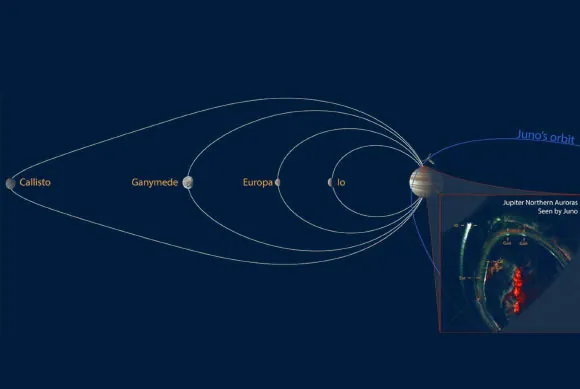
Juno Unveils Mysteries of Callisto with Stunning Ultraviolet Footprint Discovery
2025-09-04
Author: William
Jupiter's Auroral Splendor: A Cosmic Dance
Jupiter, a titan among planets, showcases the most dazzling auroras in our Solar System, painting its polar regions with mesmerizing lights. These ethereal displays allow scientists to glimpse the dynamic relationship between the gas giant and its many moons, swept along by its powerful magnetic field. Unlike the northern lights on Earth, Jupiter’s moons craft their unique auroral signatures—known as satellite footprints—illuminating their interactions with the cosmic environment.
Callisto Finally Revealed: The Last Galilean Moon's Secret Unlocked
While three of Jupiter’s largest moons—Io, Europa, and Ganymede—had their distinct auroral markers documented prior to the Juno mission, Callisto, the furthest of the Galilean moons, remained a tantalizing enigma. Multiple attempts through the NASA/ESA Hubble Space Telescope to capture Callisto’s footprint were unsuccessful, largely due to its faint signature being overshadowed by the brighter main auroral oval.
Juno's Close Encounter: A Fortunate Alignment
NASA’s Juno spacecraft, since its 2016 arrival in Jupiter's orbit, has been at the forefront of revealing the planet’s polar light shows. However, to capture Callisto's elusive footprint, a fortuitous alignment was necessary: the auroral oval needed to shift while Juno maneuvered across the magnetic field line connecting Callisto and Jupiter.
A Historic Discovery: Callisto's Auroral Footprint Confirmed
In September 2019, during Juno’s 22nd orbit, these astronomical events unfolded perfectly, unveiling Callisto's auroral footprint for the first time. This landmark observation not only confirmed that all four Galilean moons impact Jupiter’s atmosphere but also provided insights into the particle population, electromagnetic waves, and magnetic fields interlinking Callisto and Jupiter.
Solar Winds and Cosmic Connectivity
Jupiter’s magnetic field stretches far beyond its moons, forming a vast magnetosphere influenced by solar winds from the Sun. Much like Earth's auroras, Jupiter's spectacles shift in response to solar activity. Remarkably, a powerful solar stream in September 2019 temporarily nudged the auroral oval closer to Jupiter's equator, allowing the faint glimmer of Callisto’s signature to emerge.
Towards a Deeper Understanding: Future Missions on the Horizon
Dr. Jonas Rabia from the Institut de Recherche en Astrophysique et Planétologie emphasized, 'Our observations confirm the electrodynamic coupling between Callisto and Jupiter,' paving the way for continued investigation by NASA’s upcoming JUICE mission, launched in April 2023. This mission aims to further explore Callisto's environment, providing crucial insights into the moon’s interactions with Jupiter’s magnetosphere.
A Landmark Achievement in Astrophysics
These groundbreaking findings complete the picture of the auroral footprints of the Galilean moons, resolving long-standing questions about whether Callisto's electromagnetic interactions differ from those of its nearer siblings. The similarities observed suggest a universal mechanism applying to moon-planet and planet-star interactions, relevant not just within our Solar System but across other celestial systems.
Published Findings: A Step Towards Greater Cosmic Understanding
The exciting results were published in a recent issue of Nature Communications, marking a significant milestone in our quest to understand the intricate dance of celestial bodies and their magnetic fields.









 Brasil (PT)
Brasil (PT)
 Canada (EN)
Canada (EN)
 Chile (ES)
Chile (ES)
 Česko (CS)
Česko (CS)
 대한민국 (KO)
대한민국 (KO)
 España (ES)
España (ES)
 France (FR)
France (FR)
 Hong Kong (EN)
Hong Kong (EN)
 Italia (IT)
Italia (IT)
 日本 (JA)
日本 (JA)
 Magyarország (HU)
Magyarország (HU)
 Norge (NO)
Norge (NO)
 Polska (PL)
Polska (PL)
 Schweiz (DE)
Schweiz (DE)
 Singapore (EN)
Singapore (EN)
 Sverige (SV)
Sverige (SV)
 Suomi (FI)
Suomi (FI)
 Türkiye (TR)
Türkiye (TR)
 الإمارات العربية المتحدة (AR)
الإمارات العربية المتحدة (AR)